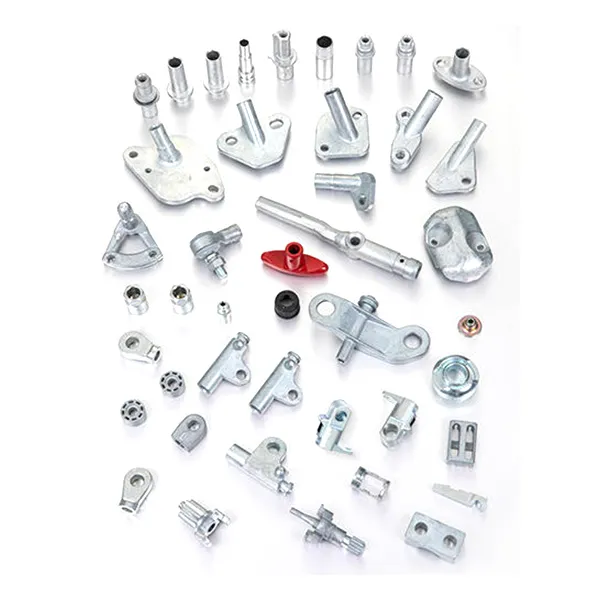How Are Zinc Alloy Parts Manufactured?
Zinc alloy parts are widely used in various industries, from automotive and aerospace to consumer electronics and home appliances. Known for their strength, durability, and cost-effectiveness, zinc alloys offer numerous advantages, making them a popular choice for producing precision parts and components. But how exactly are customized zinc alloy parts manufactured? This blog delves into the production process, from raw materials to the final product, focusing on the key methods and techniques that ensure the high quality of these versatile components.

What is a Zinc Alloy?
A zinc alloy is a metal alloy composed mainly of zinc, combined with other metals such as aluminum, copper, and magnesium. These additional metals enhance the properties of zinc, such as improving its strength, corrosion resistance, and casting performance.
Common zinc alloys include:
- Zamak alloys: A group of zinc-aluminum alloys often used for die casting.
- ZA alloys: High-performance zinc-aluminum alloys with added copper for improved strength and durability.
Zinc alloys are known for their excellent castability, dimensional stability, and versatility, making them ideal for manufacturing complex parts with precise tolerances.
Step-by-Step Manufacturing Process of Zinc Alloy Parts
1. Raw Material Preparation
The manufacturing process begins with the preparation of raw materials. Zinc ingots, which are the primary source of zinc, are combined with alloying elements such as aluminum, copper, and magnesium. The specific composition of the alloy depends on the desired properties of the final part.
The raw materials are carefully weighed and mixed to achieve the correct alloy composition. The resulting mixture is then melted in a furnace to create a homogenous molten alloy, which will be used in the casting process.
2. Casting Process
The most common method for manufacturing zinc alloy parts is die casting. Die casting involves injecting molten metal into a mold, known as a die, under high pressure. The process is ideal for creating intricate, high-precision parts with excellent surface finish and dimensional accuracy.
Here’s a breakdown of the die casting process:
- Mold Preparation: The mold, or die, is made from high-grade steel and designed according to the specifications of the part being produced. The mold consists of two halves – the fixed half and the moving half. Before casting, the mold is cleaned, and a lubricant or release agent is applied to ensure that the part can be easily removed after solidification.
- Injection: Molten zinc alloy is injected into the mold cavity at high pressure (typically between 1000 and 3000 psi). The pressure ensures that the molten metal fills every intricate detail of the mold, producing a part with high accuracy and a smooth surface finish.
- Cooling and Solidification: Once the molten metal has filled the mold, it is allowed to cool and solidify. Zinc alloys solidify quickly, which allows for faster cycle times compared to other metals like aluminum or brass.
- Ejection: After the part has solidified, the moving half of the mold opens, and the part is ejected from the mold using ejector pins. The mold is then closed, and the process repeats for the next casting.
There are two main types of die casting processes used for zinc alloy parts:
- Hot Chamber Die Casting: In this method, the melting pot is connected directly to the die casting machine, and the molten zinc is injected into the mold using a hydraulic piston. Hot chamber die casting is typically used for zinc alloys due to their low melting points and excellent fluidity.
- Cold Chamber Die Casting: This method involves melting the zinc alloy in a separate furnace, then transferring the molten metal into the injection chamber. Cold chamber die casting is used for metals with higher melting points but is less common for zinc alloys.
3. Trimming and Finishing
Once the part is ejected from the mold, excess material known as flash may remain along the edges. This excess is removed using a process called trimming, which involves cutting or grinding away the unwanted material to achieve the final shape of the part.
After trimming, additional finishing processes may be applied to improve the appearance and performance of the part. These processes include:
- Polishing: To achieve a smooth surface finish and enhance the part's aesthetic appeal.
- Plating: To improve corrosion resistance and provide a decorative finish (e.g., chrome plating or zinc plating).
- Painting or Powder Coating: For aesthetic purposes or to add an extra layer of protection.
- Machining: Some parts may require secondary machining operations, such as drilling or tapping, to achieve the desired specifications.
4. Quality Control and Inspection
Quality control is a critical aspect of manufacturing zinc alloy parts. During and after production, the parts undergo rigorous inspections to ensure that they meet the required tolerances and specifications. Quality control methods may include:
- Dimensional Inspection: Using precision measurement tools (e.g., calipers or coordinate measuring machines) to verify that the part meets the specified dimensions.
- X-Ray Testing: To check for internal defects, such as voids or porosity, that may have occurred during the casting process.
- Surface Inspection: To ensure that the part has a smooth, defect-free surface.
By conducting thorough quality checks, manufacturers can guarantee that the parts are free from defects and meet the desired performance standards.
Other Methods for Manufacturing Zinc Alloy Parts
While die casting is the most widely used method for producing zinc alloy parts, other manufacturing techniques may also be employed, depending on the application and desired properties of the part.
1. Gravity Casting
Gravity casting involves pouring molten zinc alloy into a mold and allowing gravity to fill the mold cavity. Unlike die casting, gravity casting does not involve high pressure, which makes it more suitable for producing larger, thicker-walled parts.
2. CNC Machining
For parts that require extreme precision or unique geometries that cannot be achieved through casting, CNC machining is often used. In this method, zinc alloy billets or blanks are machined using computer-controlled cutting tools to create complex shapes with tight tolerances.
3. Injection Molding
Similar to plastic injection molding, zinc alloy parts can be manufactured through a process called metal injection molding (MIM). MIM involves mixing metal powder (such as zinc alloy) with a binder, which is then injected into a mold. After molding, the part undergoes debinding and sintering to remove the binder and consolidate the metal particles. This process is ideal for producing small, complex parts with high precision.
Advantages of Zinc Alloy Parts Manufacturing
The use of zinc alloys for manufacturing offers several distinct advantages:
- Excellent Castability: Zinc alloys are known for their ability to flow easily into molds, making them ideal for producing parts with intricate shapes and fine details.
- Cost-Effective: Zinc alloy parts are often more economical to produce than those made from other metals, thanks to lower material costs, faster cycle times, and minimal secondary operations.
- High Strength and Durability: Zinc alloys provide excellent mechanical properties, including strength, hardness, and impact resistance, making them suitable for demanding applications.
- Corrosion Resistance: Zinc alloys naturally resist corrosion, especially when plated or treated with protective coatings, making them ideal for parts exposed to harsh environments.
- Recyclability: Zinc is highly recyclable, making it an environmentally friendly option for manufacturing parts.
Applications of Zinc Alloy Parts
Zinc alloy parts are used in a wide range of industries, thanks to their versatility and cost-effectiveness. Some common applications include:
- Automotive: Components such as door handles, carburetor bodies, and brackets.
- Electronics: Casings for electronic devices, connectors, and heat sinks.
- Home Appliances: Parts for washing machines, dishwashers, and other household devices.
- Aerospace: Precision components such as connectors and brackets.
- Construction: Architectural fittings, fasteners, and locks.
The manufacturing of zinc alloy parts is a complex but highly efficient process, with die casting being the dominant method due to its ability to produce precise, durable parts quickly and cost-effectively. Whether in automotive, electronics, or consumer products, zinc alloy parts are an essential part of modern manufacturing, offering strength, corrosion resistance, and versatility across a wide range of applications. By understanding the manufacturing process and the advantages of zinc alloys, businesses can make informed decisions when choosing materials for their products, ensuring high-quality, reliable performance at a reasonable cost.
Established in 2006 and located in Ningbo, Ningbo Dongzhou Transmission Co., Ltd. is a modern enterprise integrated with R&D, manufacture and trading. Dongzhou is specialized in manufacturing mechanical spare parts, farm machinery parts and auto parts like Clevises, Bolts, Clips, Rod Ends, Radial Spherical Plain Bearing, Ball Joints and so on. Visit https://www.hkdongzhou.com to discover our latest products. If you need assistance, you can get in touch with us at dongzhou@hkdongzhou.com.




